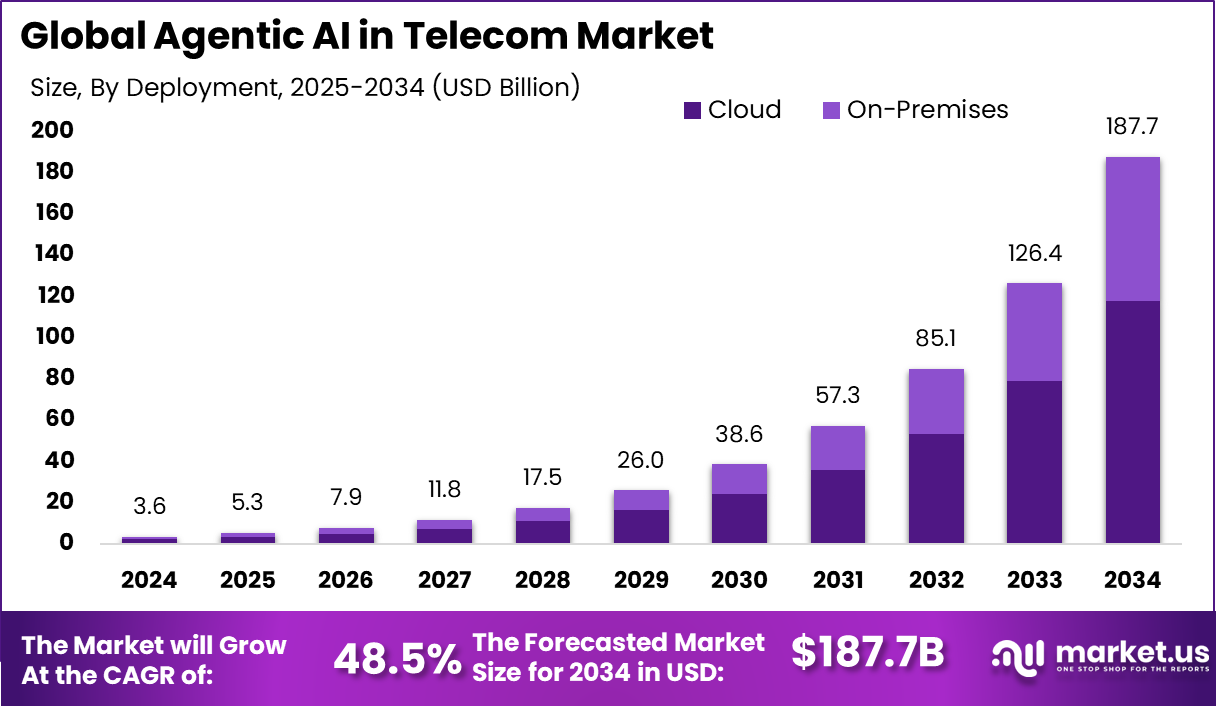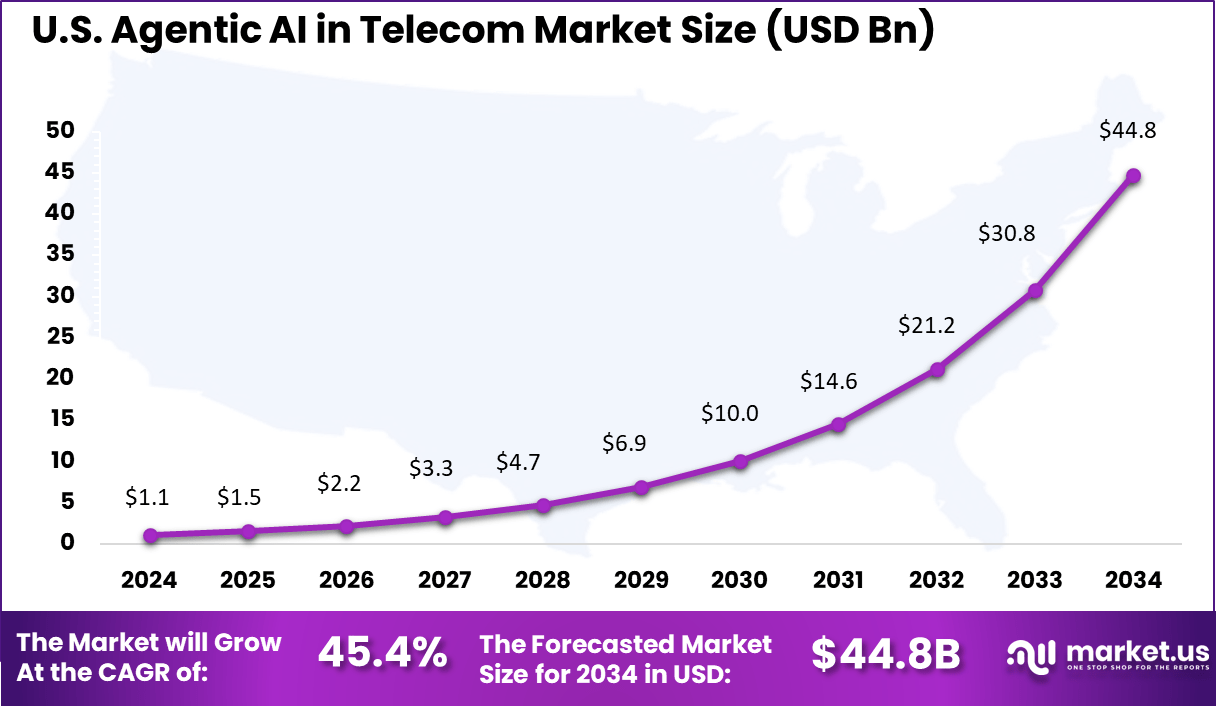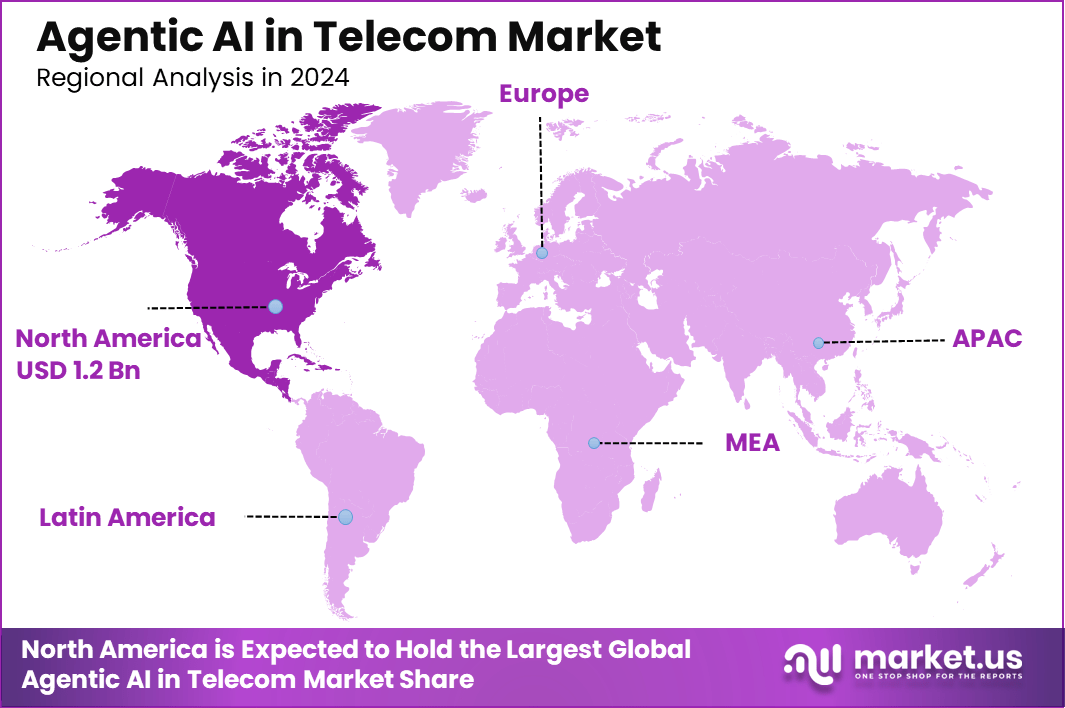Table of Contents
Agentic AI in Telecom Market Size
The Global Agentic AI in Telecom Market is undergoing a major transformation, driven by the rising demand for autonomous systems that can adapt, plan, and make decisions with minimal human input. In 2024, the market stood at USD 3.6 billion, and it is projected to grow at an exceptional CAGR of 48.5% through 2034, ultimately reaching around USD 187.7 billion. This significant growth is being fueled by telecom operators’ increasing reliance on intelligent agents to optimize network traffic, automate customer service, and enhance predictive maintenance across complex infrastructures.
Agentic AI represents a major shift in how telecommunications companies optimize, automate, and enhance their operations. Unlike simple automation, Agentic AI brings in autonomous agents capable of making informed, goal-driven decisions across network and customer domains. These agents are not just task bots; they act independently within defined guidelines, continuously monitoring vast and complex networks, analyzing real-time data, and taking proactive steps to resolve issues or improve services. Their mission is not limited to carrying out instructions but extends to achieving operational goals, improving performance metrics, and personalizing experiences for millions of users at once.

A core driver behind the adoption of Agentic AI in telecom is the need for agility in a highly competitive and quickly evolving market. Rising operational costs, surging network complexity, and ever-higher customer expectations make traditional processes inefficient. Service providers grapple with massive data flows, fluctuating network demands, and the pressure to deliver smarter, more personalized offerings. Agentic AI enables real-time, data-driven decision-making and self-managing network operations that adapt on the fly, all while controlling costs and improving reliability.
The demand for Agentic AI is propelling the sector forward primarily because of mounting pain points. Legacy systems struggle with modern network congestion, and customer support teams face overwhelming volumes of requests. Customers now expect instant, personalized service, and telecom operators risk losing out if they cannot respond swiftly. The rise of 5G, IoT devices, and cloud-driven services boosts data traffic and expands the surface area for potential problems or fraud. Agentic AI directly addresses these issues, providing scalable solutions that anticipate trouble, automate maintenance, and deliver ultra-responsive customer support.
Scope and Forecast
| Report Features | Description |
|---|---|
| Market Value (2024) | USD 3.6 Bn |
| Forecast Revenue (2034) | USD 187.7 Bn |
| CAGR (2025-2034) | 48.5% |
| Largest market in 2024 | North America [34.8% market share] |
Key Insight Summary
- The global agentic AI in telecom market is undergoing exponential growth. By 2034, the market is expected to reach USD 187.7 billion, rising from USD 3.6 billion in 2024. This reflects an impressive CAGR of 48.5% during the forecast period, largely driven by the demand for intelligent automation, network optimization, and customer-centric AI solutions.
- In 2024, North America emerged as the leading region with a 34.8% market share. The region generated approximately USD 1.2 billion in revenue, benefiting from early adoption of AI platforms and heavy investments in digital telecom infrastructure.
- Within the region, the United States contributed around USD 1.06 billion in 2024. The market in the U.S. is expected to expand at a strong CAGR of 45.4%, supported by growing integration of AI in IT operations and customer experience systems within telecom enterprises.
- By deployment type, cloud-based solutions led the market with a 62.7% share in 2024. Telecom operators increasingly prefer cloud models for their flexibility, faster deployment, and ability to scale services efficiently in real-time scenarios.
- On the technology front, natural language processing (NLP) accounted for a 38.7% share. NLP has become a core component in telecom AI strategies, enabling smarter interactions through chatbots, voice assistants, and automated service workflows.
- By application, network and IT operations management dominated the market with a 32.6% share. Telecom providers are relying on agentic AI to reduce downtime, predict network failures, and streamline operations through predictive analytics and intelligent automation.
US Market Size
The U.S. Agentic AI in Telecom Market demonstrated strong performance in 2024, reaching a valuation of USD 1.1 billion. This rapid growth is set to continue, with the market expected to expand at a CAGR of 45.4% through 2034, reaching approximately USD 44.8 billion. The surge is primarily driven by the integration of autonomous AI agents within next-generation telecom networks, enabling intelligent decision-making, automated fault resolution, and real-time network optimization.
The U.S. market benefits from a highly advanced digital infrastructure, aggressive 5G deployments, and significant investments in AI innovation. Telecom operators in the country are adopting agentic AI to enhance service delivery, reduce latency, and manage growing network complexity. As customer expectations shift toward faster, more reliable connectivity, agentic AI solutions are playing a crucial role in supporting dynamic load balancing, personalized services, and scalable network orchestration.

In 2024, North America emerged as the leading region, securing a 34.8% market share with revenue of approximately USD 1.2 billion. The region’s dominance can be attributed to the early adoption of advanced AI frameworks, robust 5G rollout, and a strong base of telecom infrastructure providers investing in agentic technologies. With growing pressure to reduce operational costs and improve service agility, North American telecom operators are leveraging agentic AI to enable real-time analytics, intelligent fault detection, and dynamic resource allocation at scale.

Emerging Trend
The Shift Toward Autonomous Networks
A key transformation now underway in telecom is the evolution of networks that can manage themselves independently, without constant human supervision. This movement goes beyond just automating simple tasks, enabling networks to recognize issues, fix problems, and optimize service quality instantly using intelligent software agents.
As these autonomous capabilities become more refined, everyday customers experience fewer service disruptions and benefit from more responsive, on-demand connectivity. The core idea is that networks are becoming not just automated, but truly adaptive to the changing needs of users and the environment, making the telecom sector both more resilient and dynamic overall.
Opportunity
Delivering Truly Personalized Experiences
There is a notable opportunity for telecom providers to use agentic AI to rethink how services are tailored to each user. By analyzing behavioral patterns and preferences in real time, AI agents can propose unique support solutions or product suggestions just when they are needed. This personalized approach can differentiate a telecom provider from competitors, helping increase customer loyalty. It means customers receive offers or troubleshooting help targeted to their specific habits and needs, rather than broad, generic messages – directly improving satisfaction and encouraging them to stay longer with that provider.
Explore More Reports
- Agentic AI in Data Democratization Market
- AI Complaint Management Market
- Gamified Learning Market
- Digital Ticketing Market
- AI Image Enhancer Market
- Self Hosting Market
- Automated Algo Trading Market
Key Market Segments
By Deployment
- Cloud
- On-Premises
By Technology
- Natural Language Processing
- Machine Learning
- Big Data
- Others (Deep Learning)
By Application
- Network/IT Operations Management
- Customer Service and Marketing VDAS
- CRM Management
- Radio Access Network
- Customer Experience Management
- Predictive Maintenance
- Others (Fraud Mitigation)
Top Key Players Covered
- IBM Corporation
- Microsoft
- Intel Corporation
- Google LLC
- AT&T Intellectual Property
- Cisco Systems, Inc.
- Nuance Communications, Inc.
- Evolv Technologies Holdings Inc.
- H2O.ai.
- Infosys Limited
- Salesforce, Inc.
- NVIDIA Corporation
- Others
Report Scope
| Report Features | Description |
|---|---|
| Base Year for Estimation | 2024 |
| Historic Period | 2020-2023 |
| Forecast Period | 2025-2034 |
| Report Coverage | Revenue forecast, AI impact on market trends, Share Insights, Company ranking, competitive landscape, Recent Developments, Market Dynamics and Emerging Trends |
| Segments Covered | By Deployment (Cloud, On-Premises), By Technology (Machine Learning, Natural Language Processing, Big Data, Others (Deep Learning)), By Application (Network/IT Operations Management, Customer Service and Marketing VDAS, CRM Management, Radio Access Network, Customer Experience Management, Predictive Maintenance, Others (Fraud Mitigation)) |
| Regional Analysis | North America – US, Canada; Europe – Germany, France, The UK, Spain, Italy, Russia, Netherlands, Rest of Europe; Asia Pacific – China, Japan, South Korea, India, New Zealand, Singapore, Thailand, Vietnam, Rest of Latin America; Latin America – Brazil, Mexico, Rest of Latin America; Middle East & Africa – South Africa, Saudi Arabia, UAE, Rest of MEA |
| Competitive Landscape | IBM Corporation, Microsoft, Intel Corporation, Google LLC, AT&T Intellectual Property, Cisco Systems, Inc., Nuance Communications, Inc., Evolv Technologies Holdings Inc., H2O.ai., Infosys Limited, Salesforce, Inc., NVIDIA Corporation, Others |
| Customization Scope | Customization for segments, region/country-level will be provided. Moreover, additional customization can be done based on the requirements. |
| Purchase Options | We have three license to opt for: Single User License, Multi-User License (Up to 5 Users), Corporate Use License (Unlimited User and Printable PDF) |
Discuss your needs with our analyst
Please share your requirements with more details so our analyst can check if they can solve your problem(s)



